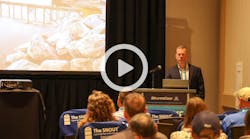
On Monday, the US Department of Agriculture (USDA) announced that as much as $260 million will be made available next year for projects to “improve the nation’s water quality, combat drought, enhance soil health, support wildlife habitat, and protect agricultural viability.” The funds will be distributed through USDA’s Natural Resources Conservation Service Regional Conservation Partnership Program (RCPP).
There’s a catch: To get the federal funding, applicants must be able to provide matching funds, either from local government sources or private investment.
The RCPP was created by the 2014 Farm Bill, and to date, says USDA, nearly 200 projects have received $600 million in the program’s first two rounds of funding. This is part of USDA’s effort to enlist farmers and ranchers in voluntary water-quality and conservation efforts, although the grants are also available to other landowners for projects on forest lands and other areas. Although the RCPP is a relatively new program, USDA has invested about $29 billion through other programs in the last seven years, involving as many as half a million farmers, ranchers, and other landowners and more than 400 million acres of land.
Last month USDA announced the 2016 RCPP projects—84 projects with total investment of $720 million in federal and matching funds. USDA selected those 84 projects from about 265 proposals. You can see a list of projects by state here.
Proposals for 2017 funding are due May 10. You can find more information on the RCPP here, and information on how to apply for a grant here.
Do you think the requirement to match federal funding with local or private investment for these projects is an effective strategy? Are you aware of RCPP-funded projects in your area?
Upcoming Webinars From Forester University
There is still time to register and earn PDH or CEU credits. Click here for a full list of upcoming webinars and webcasts.
Wednesday, March 16
Qualifying Rain Events, Sampling, & the Construction Site Monitoring Plan
How effective is your SWPPP Construction Site Monitoring Plan? Join speaker and author Mike Peters, CPESC, QSD, to explore how to design and implement a plan that thoroughly maps out the stormwater effluent sampling, monitoring, data collection, and analysis at your construction site AND meets compliance.
Click here for more information and to register.
Free Webinar: Wednesday, March 30
Using Software for Successful Project Design
Are you up-to-date on the latest design and assessment programs?
Join Matthew Welch, CESSWI, for this free webinar sponsored by Profile Products to explore the latest in project design software; its parameters, calculations, and applications; and how you can put it to work at your sites coupled with the Five Fundamentals to maximize your erosion/sediment control and revegetation success.
Click here for more information and to register.
Thursday, April 7
Sidewalks & Recreational Trails: Design, Evaluation, and Management
Did you know that there are more than 1 million miles of sidewalk in North America, and 15-20% need repairs…estimated at $15 billion? Join David Hein to explore the latest innovation in sidewalks and recreation trail design, construction, and maintenance, and how you can apply these techniques to your sidewalks and trails to extend their lifetime, meet compliance, and reduce your costs.
Click here for more information and to register.
April 12 and 14
Hydraulics 101 (for Those Who Skipped It in College)
At a loss when hydraulic engineers start talking? Join former IECA president David Williams to learn to “talk the talk” and better understand your hydraulic engineers and their reports when they’re talking in terms of unsteady flow, allowable sheer stress, Manning’s “n,” etc. In this second part of our Surface Water Master Class series, Williams presents a live and on-demand two-session webinar, where he’ll discuss the base concepts, terms, and analyses behind hydraulics and hydraulic studies, as well as advanced topics (e.g., hydraulic scour of structures, weirs, culverts, hydraulic grade control, and bank stabilization), and how all of these are essential for effective hydraulic design.
Click here for more information and to register.
April 20–May 26
Sediment & Erosion Control for Construction Sites Master Class Series
Join industry experts Jerald Fifield and Tina Evans for a comprehensive, six-part live and on-demand master class and workshop series exploring the ins and outs of effective sediment and erosion control plan design and review for construction sites. Enjoy six online lectures and Q&A sessions and three interactive workshops presented by Fifield and Evans, delving into Fifield’s best-selling third edition of Designing and Reviewing Effective Sediment and Erosion Control Plans (included in your Master Class Series package).
Click here for more information and to register.
Thursday, May 15
Stormwater Treatment Maintenance: What Works and How to Do It
A major struggle for all stormwater managers is developing an adequate stormwater treatment maintenance program…on a budget. Join returning speaker and author Andrew Erickson to explore the best practices in stormwater treatment maintenance design, implementation, and budgeting, as well as real-world data and examples of what works (and doesn’t).
Click here for more information and to register.
About the Author
Janice Kaspersen
Janice Kaspersen is the former editor of Erosion Control and Stormwater magazines.

